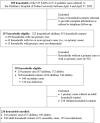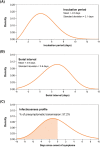Household transmission of SARS-CoV-2 during the Omicron wave in Shanghai, China: A case-ascertained study
- PMID: 36843225
- PMCID: PMC9946695
- DOI: 10.1111/irv.13097
Household transmission of SARS-CoV-2 during the Omicron wave in Shanghai, China: A case-ascertained study
Abstract
Objectives: We used a case-ascertained study to determine the features of household transmission of SARS-CoV-2 Omicron variant in Shanghai, China.
Methods: In April 2022, we carried out a household transmission study from 309 households of 335 SARS-CoV-2 pediatric cases referred to a designated tertiary Children's Hospital. The detailed information can be collected from the 297 households for estimating the transmission parameters. The 236 households were qualified for estimating the secondary infection attack rates (SARI ) and secondary clinical attack rates (SARC ) among adult household contacts, characterizing the transmission heterogeneities in infectivity and susceptibility, and assessing the vaccine effectiveness.
Results: We estimated the mean incubation period and serial interval of Omicron variant to be 4.6 ± 2.1 and 3.9 ± 3.7 days, respectively, with 57.2% of the transmission events occurring at the presymptomatic phase. The overall SARI and SARC among adult household contacts were 77.11% (95% confidence interval [CI]: 73.58%-80.63%) and 67.03% (63.09%-70.98%). We found higher household susceptibility in females. Infectivity was not significantly different between children and adults and symptomatic and asymptomatic cases. Two-dose and booster-dose of inactivated COVID-19 vaccination were 14.8% (5.8%-22.9%) and 18.9% (9.0%-27.7%) effective against Omicron infection and 21.5% (10.4%-31.2%) and 24.3% (12.3%-34.7%) effective against the symptomatic disease.
Conclusions: We found high household transmission during the Omicron wave in Shanghai due to presymptomatic and asymptomatic transmission despite implementation of strict interventions, indicating the importance of early detection and timely isolation of SARS-CoV-2 infections. Marginal effectiveness of inactivated vaccines against Omicron infection poses a great challenge for outbreak containment.
Keywords: Omicron variant; SARS-CoV-2; household transmission; vaccine effectiveness.
© 2023 The Authors. Influenza and Other Respiratory Viruses published by John Wiley & Sons Ltd.
Conflict of interest statement
All the authors declared no conflicts of interest related to this work.
Figures


References
-
- World Health Organization . WHO Health Emergency Dashboard. Available at: https://covid19.who.int/. Accessed 6 July 2022.
-
- World Health Organization . Weekly epidemiological update on COVID‐19‐1 March 2022. Available from: https://www.who.int/publications/m/item/weekly-epidemiological-update-on.... Accessed 31 March 2022.
-
- World Health Organization . Enhancing response to Omicron SARS‐CoV‐2 variant: Technical brief and priority actions for Member States. Available at: https://www.who.int/publications/m/item/enhancing-readiness-for-omicron-.... Accessed 22 April 2022.
-
- National Health Commission of The People's Republic of China . Technical guideline for COVID‐19 vaccination (the first version). 29 March 2021. Available from: http://www.nhc.gov.cn/jkj/s3582/202103/c2febfd04fc5498f916b1be080905771..... Accessed 22 April 2022.
Publication types
MeSH terms
Substances
Supplementary concepts
LinkOut - more resources
Full Text Sources
Medical
Miscellaneous

